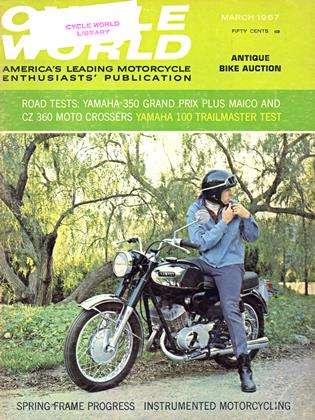YAMAHA 100 TRAILMASTER
Trail Test
WHAT DOES ONE DO for an encore? Just take a good look at what Yamaha has done after several years of making one of the most successful trail bikes ever. The new 100 Trailmaster is not a rehash of the old one, nor is it a street machine with knobby tires, high exhaust pipe and engine guard, although it does have these things. It is, by all means, the answer to what the American trail bike buyer has been wanting Yamaha to do for some time.
The wheelbase has been lengthened from 45 to 46.7 inches and the Trailmaster sports full-size 18-inch wheels front and back on which ample 2.75-inch knobbies are mounted. To give you an idea of the thinking that has gone into this machine, the swing arm is 16-1/2 inches long, equal to the swing arm length of several very competitive 250cc scramblers. This characteristic, of course, contributes greatly to the 100’s stability.
As the front fork rake has been increased, too, it comes as a surprise that the wheelbase is not longer. But this is one of those short in the middle, long at both ends dirt bikes — a very successful formula these days.
The frame remains the same, a pressed steel affair that is welded together. Ground clearance is up to 8-1/2 inches. Effective wheel travel, well dampened both fore and aft, is superlative, and as the shielded exhaust system is a U. S.-approved Yamaha-Krizman spark arrester, the Trailmaster has the makings of a nearperfect woods bike.
A dual-sprocket set-up is standard. With the chain running on the larger of the two, the tractable Trailmaster could win “slow” races against a turtle, feet up. But the wide-ratio gearbox will permit one to run at 35 to 40 mph with the large sprocket. Switching to the smaller street sprocket will give top speeds between 65 and 70 mph. Yamaha has thoughtfully provided a chain guide, indispensible to keep things on track over rough ground.
You’ll note the roomy (and very sturdily mounted) baggage rack to accommodate Mighty Hunter types on their return from deer country. Its only drawback is that it leaves little move-about space for the rider’s hindside should he be inclined to ride fast and want to sit rearward for a blast through the soft or sandy stuff. Fortunately, one may obtain a fuller seat, at the cost of dispensing with all that baggage space.
The 96.8cc rotary disc valve single-cylinder engine is ideal for the job at hand. It’s not set up to scream; it merely pulls strongly throughout what seems to be the entire rev range. Low-end torque is there in very usable form for such applications as climbing up steep banks from a dead start or popping wheelies over logs, using only the throttle hand and very little athletic ability.
Topping it all off is one of the quietest electric starters we’ve ever heard, the Autolube automatic oil mixing system, fully street-worthy lighting, and instrumentation including neutral, battery and high beam lights.
In sum: a sturdy, speedy, highly refined trail scooter. ■












